1998 VOLVO V90 AUX
[x] Cancel search: AUXPage 18 of 175
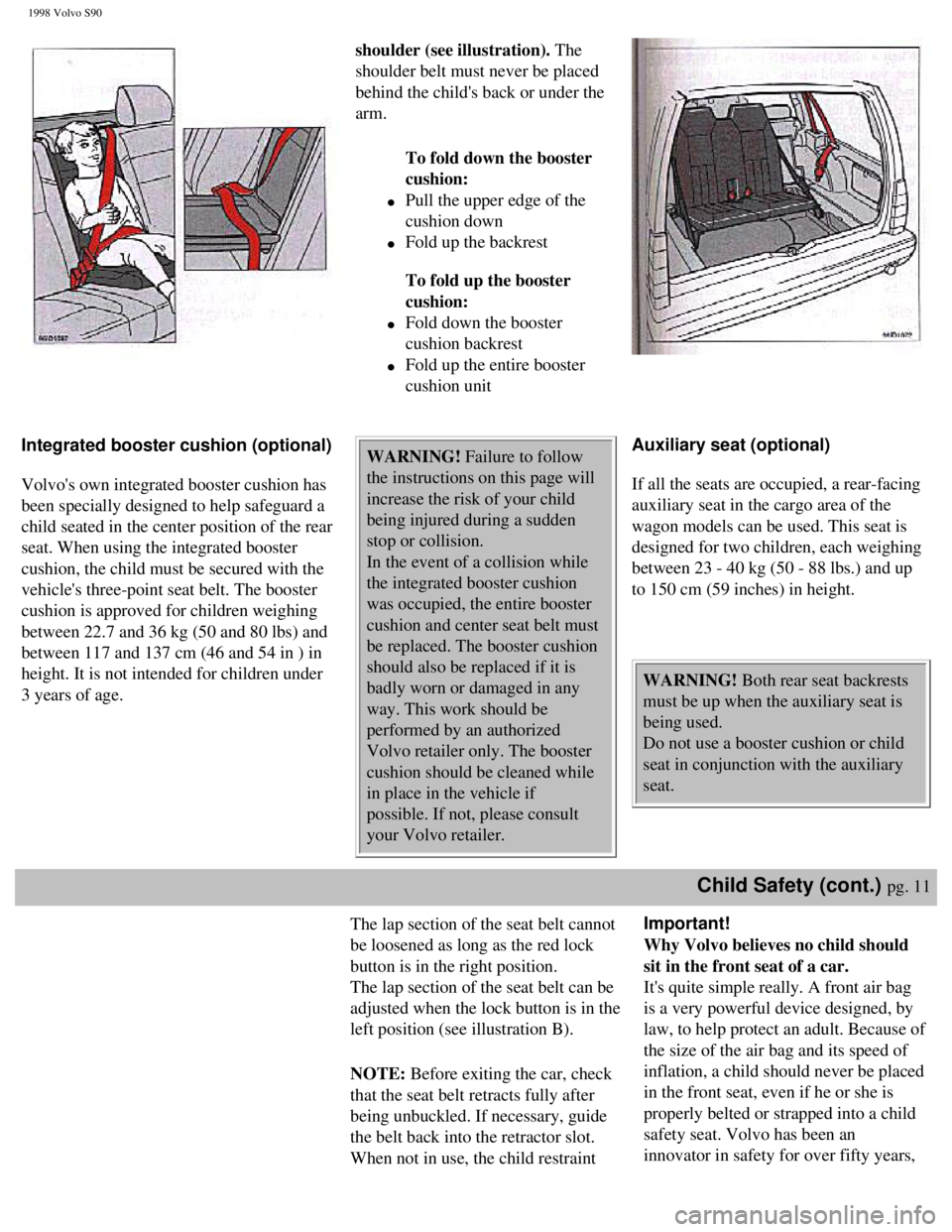
1998 Volvo S90
shoulder (see illustration). The
shoulder belt must never be placed
behind the child's back or under the
arm. To fold down the booster
cushion:
l Pull the upper edge of the
cushion down
l Fold up the backrest
To fold up the booster
cushion:
l Fold down the booster
cushion backrest
l Fold up the entire booster
cushion unit
Integrated booster cushion (optional)
Volvo's own integrated booster cushion has
been specially designed to help safeguard a
child seated in the center position of the rear
seat. When using the integrated booster
cushion, the child must be secured with the
vehicle's three-point seat belt. The booster
cushion is approved for children weighing
between 22.7 and 36 kg (50 and 80 lbs) and
between 117 and 137 cm (46 and 54 in ) in
height. It is not intended for children under
3 years of age. WARNING! Failure to follow
the instructions on this page will
increase the risk of your child
being injured during a sudden
stop or collision.
In the event of a collision while
the integrated booster cushion
was occupied, the entire booster
cushion and center seat belt must
be replaced. The booster cushion
should also be replaced if it is
badly worn or damaged in any
way. This work should be
performed by an authorized
Volvo retailer only. The booster
cushion should be cleaned while
in place in the vehicle if
possible. If not, please consult
your Volvo retailer. Auxiliary seat (optional)
If all the seats are occupied, a rear-facing
auxiliary seat in the cargo area of the
wagon models can be used. This seat is
designed for two children, each weighing
between 23 - 40 kg (50 - 88 lbs.) and up
to 150 cm (59 inches) in height.
WARNING! Both rear seat backrests
must be up when the auxiliary seat is
being used.
Do not use a booster cushion or child
seat in conjunction with the auxiliary
seat.
Child Safety (cont.) pg. 11
The lap section of the seat belt cannot
be loosened as long as the red lock
button is in the right position.
The lap section of the seat belt can be
adjusted when the lock button is in the
left position (see illustration B).
NOTE: Before exiting the car, check
that the seat belt retracts fully after
being unbuckled. If necessary, guide
the belt back into the retractor slot.
When not in use, the child restraint Important!
Why Volvo believes no child should
sit in the front seat of a car.
It's quite simple really. A front air bag
is a very powerful device designed, by
law, to help protect an adult. Because of
the size of the air bag and its speed of
inflation, a child should never be placed
in the front seat, even if he or she is
properly belted or strapped into a child
safety seat. Volvo has been an
innovator in safety for over fifty years,
file:///K|/ownersdocs/1998/1998_SV90/98S90_009.htm (2 of 5)12/30/2006 \
1:52:35 PM
Page 19 of 175
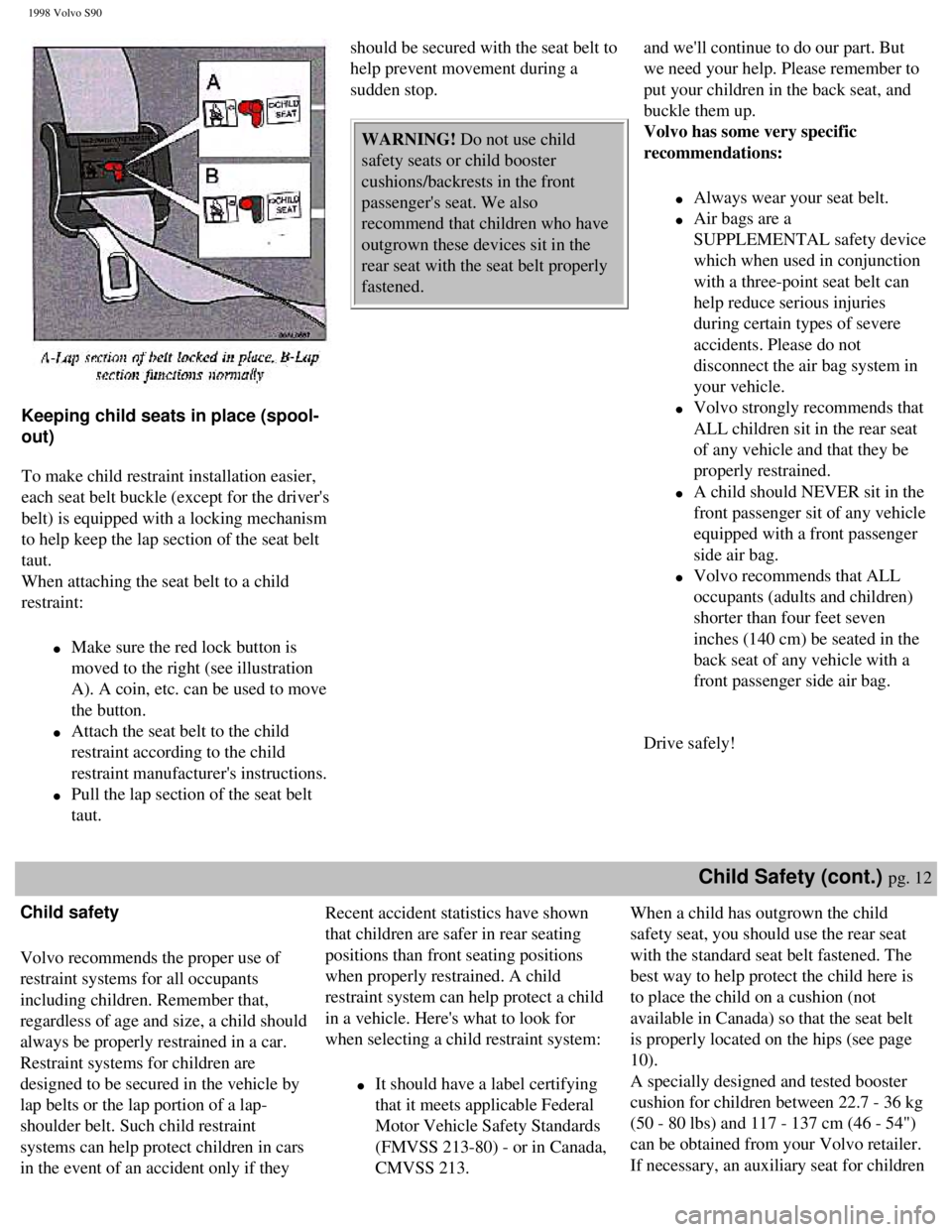
1998 Volvo S90
Keeping child seats in place (spool-
out)
To make child restraint installation easier,
each seat belt buckle (except for the driver's
belt) is equipped with a locking mechanism
to help keep the lap section of the seat belt
taut.
When attaching the seat belt to a child
restraint:
l Make sure the red lock button is
moved to the right (see illustration
A). A coin, etc. can be used to move
the button.
l Attach the seat belt to the child
restraint according to the child
restraint manufacturer's instructions.
l Pull the lap section of the seat belt
taut.
should be secured with the seat belt to
help prevent movement during a
sudden stop.
WARNING! Do not use child
safety seats or child booster
cushions/backrests in the front
passenger's seat. We also
recommend that children who have
outgrown these devices sit in the
rear seat with the seat belt properly
fastened. and we'll continue to do our part. But
we need your help. Please remember to
put your children in the back seat, and
buckle them up.
Volvo has some very specific
recommendations:
l Always wear your seat belt.
l Air bags are a
SUPPLEMENTAL safety device
which when used in conjunction
with a three-point seat belt can
help reduce serious injuries
during certain types of severe
accidents. Please do not
disconnect the air bag system in
your vehicle.
l Volvo strongly recommends that
ALL children sit in the rear seat
of any vehicle and that they be
properly restrained.
l A child should NEVER sit in the
front passenger sit of any vehicle
equipped with a front passenger
side air bag.
l Volvo recommends that ALL
occupants (adults and children)
shorter than four feet seven
inches (140 cm) be seated in the
back seat of any vehicle with a
front passenger side air bag.
Drive safely!
Child Safety (cont.) pg. 12
Child safety
Volvo recommends the proper use of
restraint systems for all occupants
including children. Remember that,
regardless of age and size, a child should
always be properly restrained in a car.
Restraint systems for children are
designed to be secured in the vehicle by
lap belts or the lap portion of a lap-
shoulder belt. Such child restraint
systems can help protect children in cars
in the event of an accident only if they
Recent accident statistics have shown
that children are safer in rear seating
positions than front seating positions
when properly restrained. A child
restraint system can help protect a child
in a vehicle. Here's what to look for
when selecting a child restraint system:
l It should have a label certifying
that it meets applicable Federal
Motor Vehicle Safety Standards
(FMVSS 213-80) - or in Canada,
CMVSS 213.
When a child has outgrown the child
safety seat, you should use the rear seat
with the standard seat belt fastened. The
best way to help protect the child here is
to place the child on a cushion (not
available in Canada) so that the seat belt
is properly located on the hips (see page
10).
A specially designed and tested booster
cushion for children between 22.7 - 36 kg
(50 - 80 lbs) and 117 - 137 cm (46 - 54")
can be obtained from your Volvo retailer.
If necessary, an auxiliary seat for children
file:///K|/ownersdocs/1998/1998_SV90/98S90_009.htm (3 of 5)12/30/2006 \
1:52:35 PM
Page 20 of 175

1998 Volvo S90
are used properly. However, children
could be endangered in a crash if the
child restraints are not properly secured
in the vehicle. Failure to follow the
installation instructions for your child
restraint can result in your child striking
the vehicle's interior in a sudden stop.
Holding a child in your arms is NOT a
suitable substitute for a child restraint
system. In an accident, a child held in a
person's arms can be crushed between
the vehicle's interior and an unrestrained
person. The child could also be injured
by striking the interior, or by being
ejected from the vehicle during a sudden
maneuver or impact. The same can also
happen if the infant or child rides
unrestrained on the seat. Other
occupants should also be properly
restrained to help reduce the chance of
injuring or increasing the injury of a
child. All states and provinces have
legislation governing how and where
children should be carried in a car. Find
out the regulations existing in your state
or province. l Make sure the child restraint
system is approved for the child's
height, weight and development -
the label required by the standard
or regulation, or instructions for
infant restraints, typically provide
this information.
l In using any child restraint
system, we urge you to look
carefully over the instructions
that are provided with the
restraint. Be sure you
understand them and can use
the device properly and safely
in this vehicle. A misused child
restraint system can result in
increased injuries for both the
infant or child and other
occupants in the vehicle.
l If your child restraint requires a
top tether strap, consult your
authorized Volvo retailer for top
tether anchorage and installation
information.
is available for use in the luggage
compartment of station wagon models.
This seat is designed for two children,
each weighing between 23 - 40 kg (50 -
88 lbs.) and up to 150 cm (59 inches) in
height.
WARNING!
l When using the auxiliary seat
for children, both sections of
the rear seat backrest must be
secured in the upright position
l Do not use a booster cushion or
child seat in conjunction with
the auxiliary seat.
Occupant Safety pg. 13
Seat belt maintenance
Check periodically that the anchor bolts
are secure and that the belts are in good
condition. Use water and a mild
detergent for cleaning. Check seat belt
mechanism function as follows: Attach
the seat belt and pull rapidly on the strap.
Volvo Concern for Safety
Safety is the cornerstone for Volvo. Our
concern dates back to 1927 when the
first Volvo rolled off the production line.
Three-point seat belts (a Volvo
invention), safety cages, and energy-
absorbing impact zones were designed
into Volvo cars long before it was
fashionable or required by government
regulation. We will not compromise our
commitment to safety. We continue to
seek out new safety features and to refine
those already in our cars. You can help.
We would appreciate hearing your
suggestions about improving automobile
Occupant safety
How safely you drive doesn't depend on
how old you are but rather on:
l how well you see
l your ability to concentrate
l how quickly you make decisions
under stress to avoid an accident.
The tips listed below are
suggestions to help you cope with
the ever changing traffic
environment.
l Never drink and drive.
l If you are taking any medication,
consult your physician about its
potential effects on your driving
abilities.
l Take a driver-retraining course
l Have your eyes checked regularly
l Keep your windshield and
headlamps clean.
l Replace wiper blades when they
start to leave streaks.
l Take into account the traffic,
Reporting Safety Defects in
the U.S.
If you believe that your vehicle has a
defect which could cause a crash or
could cause injury or death, you
should immediately inform the
National Highway Traffic Safety
Administration (NHTSA) in
addition to notifying Volvo Cars of
North America. If NHTSA receives
similar complaints, it may open an
investigation, and if it finds that a
safety defect exists in a group of
vehicles, it may order a recall and
remedy campaign. However,
NHTSA cannot become involved in
individual problems between you,
your retailer, or Volvo Cars of North
America. To contact NHTSA, you
may either call the Auto Safety
Hotline toll-free at 1-800-424-9393
file:///K|/ownersdocs/1998/1998_SV90/98S90_009.htm (4 of 5)12/30/2006 \
1:52:35 PM
Page 52 of 175
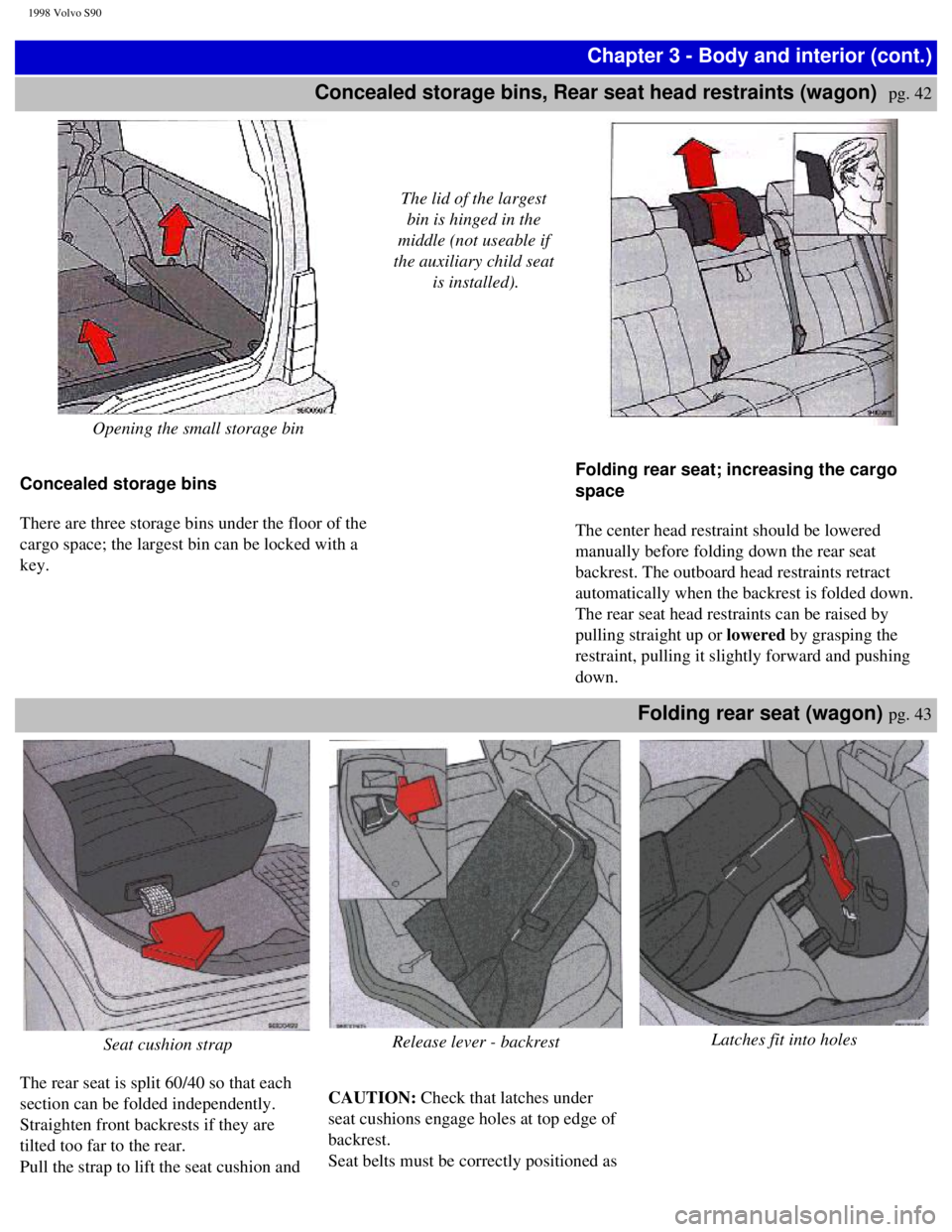
1998 Volvo S90
Chapter 3 - Body and interior (cont.)
Concealed storage bins, Rear seat head restraints (wagon)
pg. 42
Opening the small storage bin
Concealed storage bins
There are three storage bins under the floor of the
cargo space; the largest bin can be locked with a
key.
The lid of the largest
bin is hinged in the
middle (not useable if
the auxiliary child seat is installed).
Folding rear seat; increasing the cargo
space
The center head restraint should be lowered
manually before folding down the rear seat
backrest. The outboard head restraints retract
automatically when the backrest is folded down.
The rear seat head restraints can be raised by
pulling straight up or lowered by grasping the
restraint, pulling it slightly forward and pushing
down.
Folding rear seat (wagon) pg. 43
Seat cushion strap
The rear seat is split 60/40 so that each
section can be folded independently.
Straighten front backrests if they are
tilted too far to the rear.
Pull the strap to lift the seat cushion and
Release lever - backrest
CAUTION: Check that latches under
seat cushions engage holes at top edge of
backrest.
Seat belts must be correctly positioned as
Latches fit into holes
file:///K|/ownersdocs/1998/1998_SV90/98S90_042.htm (1 of 4)12/30/2006 \
1:52:40 PM
Page 54 of 175

1998 Volvo S90
WARNING! The eyelets are not to
be used as passenger restraints or as
anchorages for child restraints. See
page 9.
Wagons only:
Unless the station wagon is
equipped with Volvo's auxiliary seat
for children (option) passengers
should not ride in the rear cargo
area.
Cargo space lighting, Spare tire and jack (wagon) pg. 45
Cargo space lighting
There is an extra courtesy light at the rear of the cargo space.
1 Light comes on when the tailgate is opened
2 The light is always OFF
3 The light is always ON Spare tire and jack
The spare tire and the jack are located beneath the floor mat
in the large storage bin. Always secure the spare tire and the
jack to prevent them from rattling.
NOTE: See pages 78-79 for information on how the jack
should be used.
Cargo space (wagon), loading pg. 46
Load the cargo against the backrest
Load both sections of the backrest
Tie down the cargo
file:///K|/ownersdocs/1998/1998_SV90/98S90_042.htm (3 of 4)12/30/2006 \
1:52:40 PM
Page 55 of 175
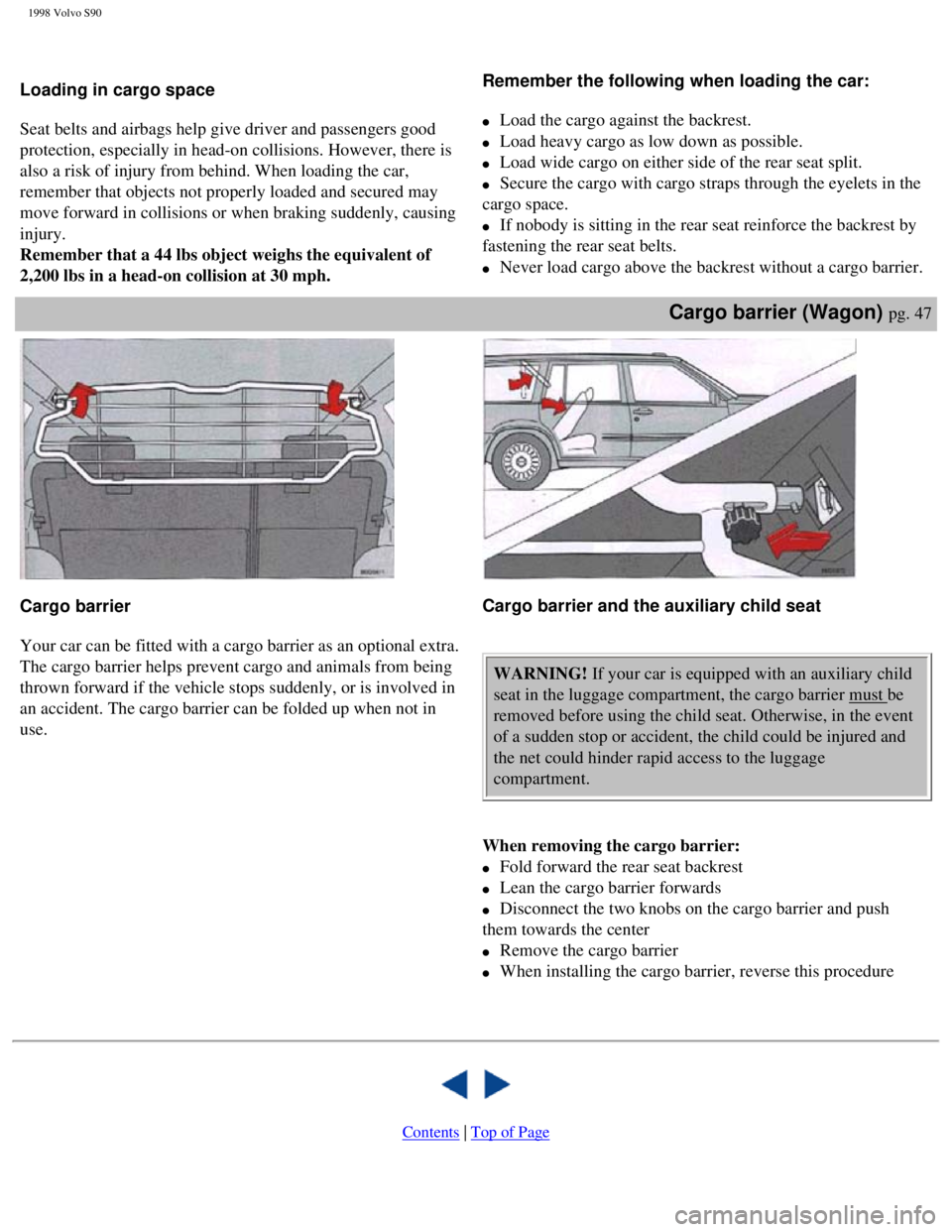
1998 Volvo S90
Loading in cargo space
Seat belts and airbags help give driver and passengers good
protection, especially in head-on collisions. However, there is
also a risk of injury from behind. When loading the car,
remember that objects not properly loaded and secured may
move forward in collisions or when braking suddenly, causing
injury.
Remember that a 44 lbs object weighs the equivalent of
2,200 lbs in a head-on collision at 30 mph.
Remember the following when loading the car:
l Load the cargo against the backrest.
l Load heavy cargo as low down as possible.
l Load wide cargo on either side of the rear seat split.
l Secure the cargo with cargo straps through the eyelets in the
cargo space.
l If nobody is sitting in the rear seat reinforce the backrest by
fastening the rear seat belts.
l Never load cargo above the backrest without a cargo barrier.
Cargo barrier (Wagon) pg. 47
Cargo barrier
Your car can be fitted with a cargo barrier as an optional extra.
The cargo barrier helps prevent cargo and animals from being
thrown forward if the vehicle stops suddenly, or is involved in
an accident. The cargo barrier can be folded up when not in
use.
Cargo barrier and the auxiliary child seat
WARNING! If your car is equipped with an auxiliary child
seat in the luggage compartment, the cargo barrier must be
removed before using the child seat. Otherwise, in the event
of a sudden stop or accident, the child could be injured and
the net could hinder rapid access to the luggage
compartment.
When removing the cargo barrier:
l Fold forward the rear seat backrest
l Lean the cargo barrier forwards
l Disconnect the two knobs on the cargo barrier and push
them towards the center
l Remove the cargo barrier
l When installing the cargo barrier, reverse this procedure
Contents | Top of Page
file:///K|/ownersdocs/1998/1998_SV90/98S90_042.htm (4 of 4)12/30/2006 \
1:52:40 PM
Page 69 of 175
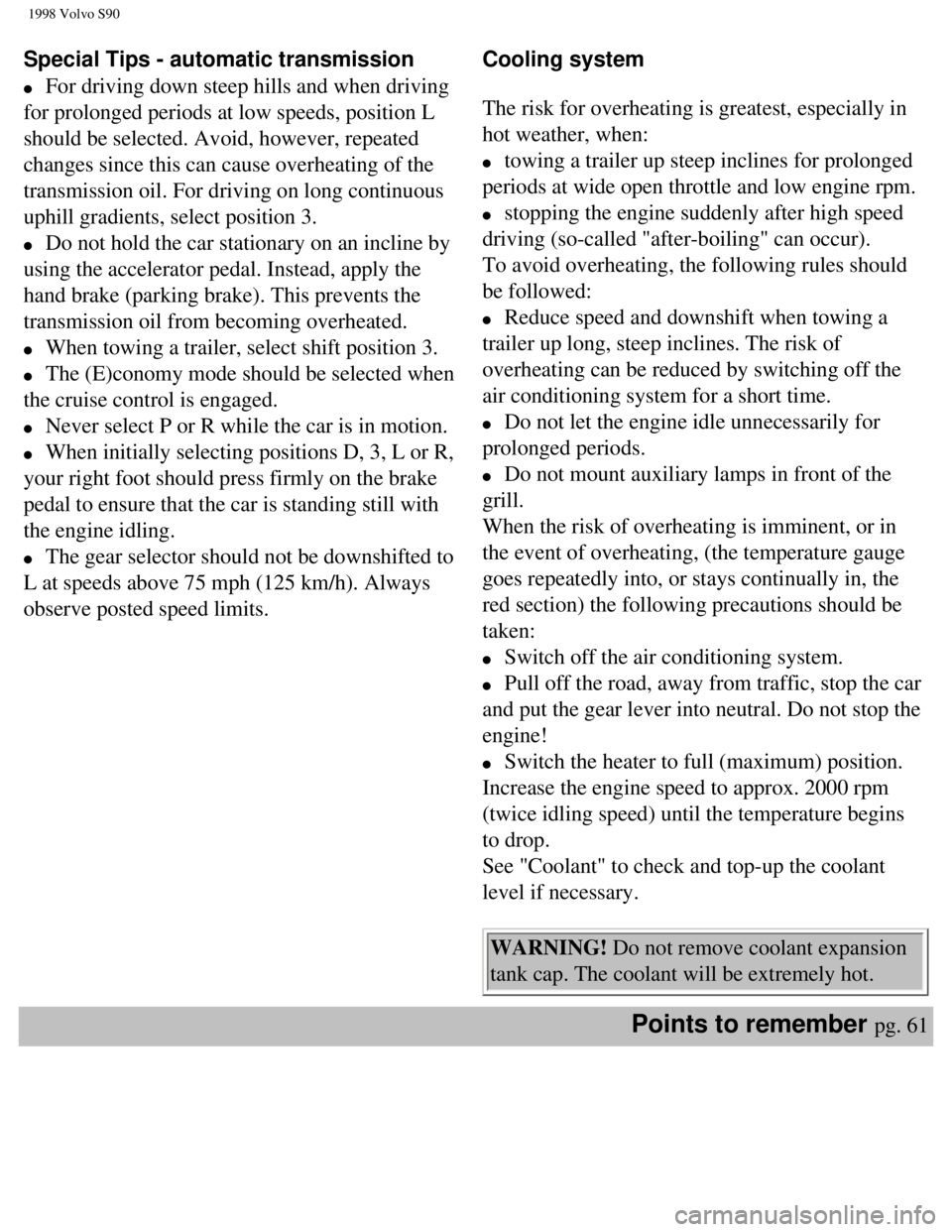
1998 Volvo S90
Special Tips - automatic transmission
l For driving down steep hills and when driving
for prolonged periods at low speeds, position L
should be selected. Avoid, however, repeated
changes since this can cause overheating of the
transmission oil. For driving on long continuous
uphill gradients, select position 3.
l Do not hold the car stationary on an incline by
using the accelerator pedal. Instead, apply the
hand brake (parking brake). This prevents the
transmission oil from becoming overheated.
l When towing a trailer, select shift position 3.
l The (E)conomy mode should be selected when
the cruise control is engaged.
l Never select P or R while the car is in motion.
l When initially selecting positions D, 3, L or R,
your right foot should press firmly on the brake
pedal to ensure that the car is standing still with
the engine idling.
l The gear selector should not be downshifted to
L at speeds above 75 mph (125 km/h). Always
observe posted speed limits. Cooling system
The risk for overheating is greatest, especially in
hot weather, when:
l towing a trailer up steep inclines for prolonged
periods at wide open throttle and low engine rpm.
l stopping the engine suddenly after high speed
driving (so-called "after-boiling" can occur).
To avoid overheating, the following rules should
be followed:
l Reduce speed and downshift when towing a
trailer up long, steep inclines. The risk of
overheating can be reduced by switching off the
air conditioning system for a short time.
l Do not let the engine idle unnecessarily for
prolonged periods.
l Do not mount auxiliary lamps in front of the
grill.
When the risk of overheating is imminent, or in
the event of overheating, (the temperature gauge
goes repeatedly into, or stays continually in, the
red section) the following precautions should be
taken:
l Switch off the air conditioning system.
l Pull off the road, away from traffic, stop the car
and put the gear lever into neutral. Do not stop the
engine!
l Switch the heater to full (maximum) position.
Increase the engine speed to approx. 2000 rpm
(twice idling speed) until the temperature begins
to drop.
See "Coolant" to check and top-up the coolant
level if necessary.
WARNING! Do not remove coolant expansion
tank cap. The coolant will be extremely hot.
Points to remember pg. 61
file:///K|/ownersdocs/1998/1998_SV90/98S90_058.htm (4 of 7)12/30/2006 \
1:52:42 PM
Page 110 of 175
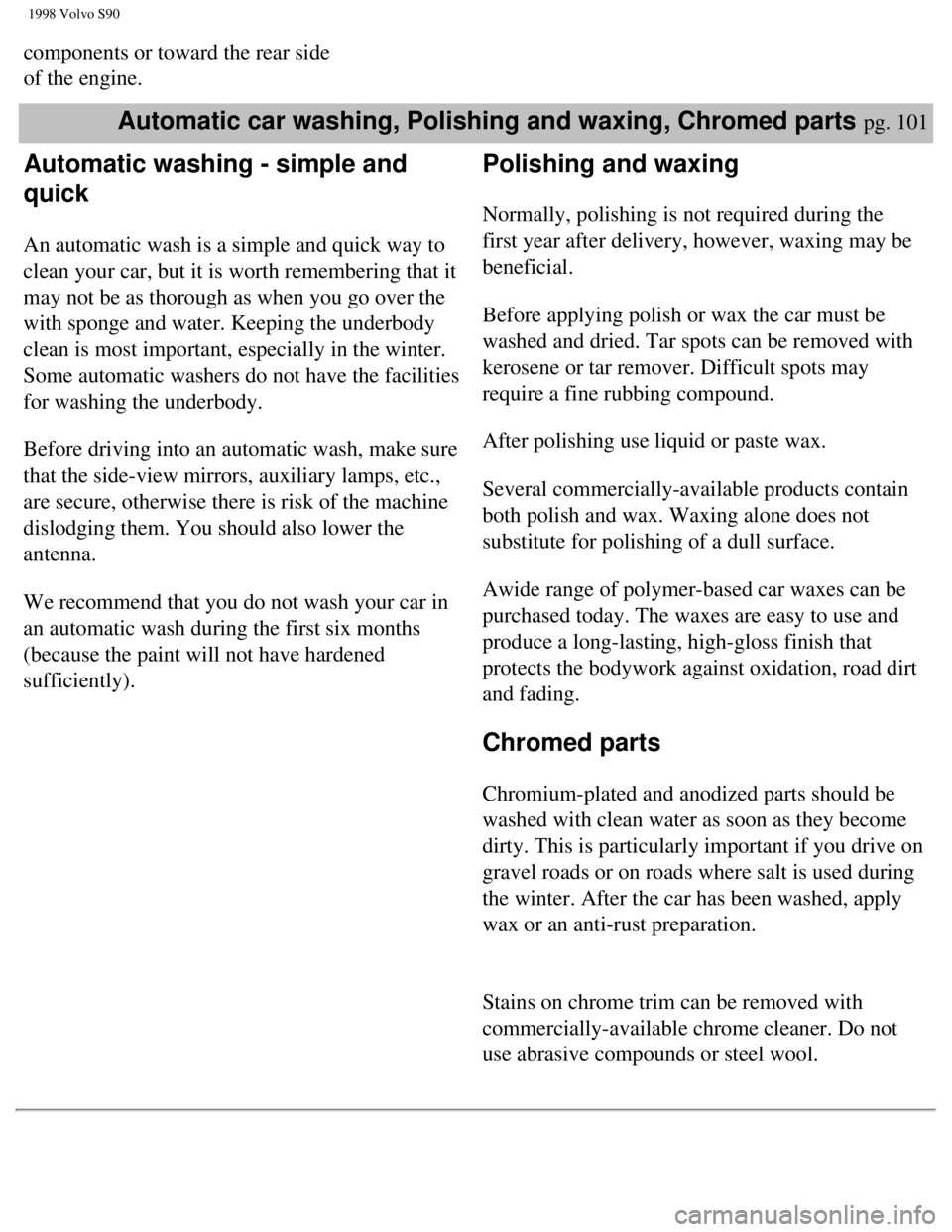
1998 Volvo S90
components or toward the rear side
of the engine.
Automatic car washing, Polishing and waxing, Chromed parts pg. 101
Automatic washing - simple and
quick
An automatic wash is a simple and quick way to
clean your car, but it is worth remembering that it
may not be as thorough as when you go over the
with sponge and water. Keeping the underbody
clean is most important, especially in the winter.
Some automatic washers do not have the facilities
for washing the underbody.
Before driving into an automatic wash, make sure
that the side-view mirrors, auxiliary lamps, etc.,
are secure, otherwise there is risk of the machine
dislodging them. You should also lower the
antenna.
We recommend that you do not wash your car in
an automatic wash during the first six months
(because the paint will not have hardened
sufficiently).
Polishing and waxing
Normally, polishing is not required during the
first year after delivery, however, waxing may be
beneficial.
Before applying polish or wax the car must be
washed and dried. Tar spots can be removed with
kerosene or tar remover. Difficult spots may
require a fine rubbing compound.
After polishing use liquid or paste wax.
Several commercially-available products contain
both polish and wax. Waxing alone does not
substitute for polishing of a dull surface.
Awide range of polymer-based car waxes can be
purchased today. The waxes are easy to use and
produce a long-lasting, high-gloss finish that
protects the bodywork against oxidation, road dirt
and fading.
Chromed parts
Chromium-plated and anodized parts should be
washed with clean water as soon as they become
dirty. This is particularly important if you drive on
gravel roads or on roads where salt is used during
the winter. After the car has been washed, apply
wax or an anti-rust preparation.
Stains on chrome trim can be removed with
commercially-available chrome cleaner. Do not
use abrasive compounds or steel wool.
file:///K|/ownersdocs/1998/1998_SV90/98S90_097.htm (5 of 6)12/30/2006 \
1:52:47 PM